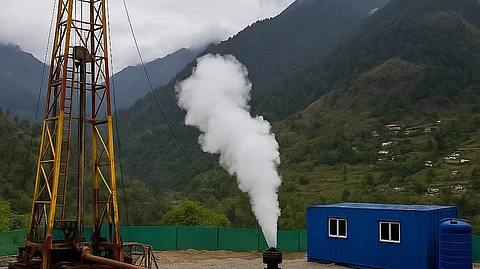
- Home
- Live Blog
- Breaking News
- Top Headlines
- Cities
- NE News
- Sentinel Media
- Sports
- Education
- Jobs

ITANAGAR: In a significant breakthrough for clean energy in the region, the Centre for Earth Sciences and Himalayan Studies (CESHS) has successfully drilled Northeast India’s first geothermal production well in Dirang, located in Arunachal Pradesh’s West Kameng district.
This landmark achievement, confirmed by CESHS officials on Monday, marks a pivotal step in harnessing geothermal energy for sustainable development in high-altitude regions.
Rupankar Rajkhowa, Head of the CESHS Geosciences Division, stated that the well was drilled after two years of rigorous geochemical and structural surveys across western Arunachal Pradesh. He described the initiative as the first of its kind in the Northeast, emphasizing its importance in developing eco-friendly energy alternatives. The geothermal energy produced from the well is expected to support applications such as drying fruits, nuts, and meat, space heating, and controlled-atmosphere storage systems — innovations that can greatly benefit agriculture and daily life in Arunachal’s remote, mountainous communities.
The project was spearheaded by CESHS in collaboration with the Norwegian Geotechnical Institute (NGI) in Oslo, Icelandic geothermal firm Geotropy ehf, and Guwahati Boring Service, which oversaw the drilling operations. Advanced analyses indicated that Dirang is a medium-to-high enthalpy geothermal zone, with reservoir temperatures reaching up to 115°C — ideal for direct-use applications without the need for conversion to electricity.
Detailed geological mapping showed the presence of quartzite over schist formations along tectonic boundaries near the Main Central Thrust, mirroring geological features found in other Himalayan regions. These findings were crucial in guiding precise drilling while ensuring minimal environmental disruption.
Supported by the Ministry of Earth Sciences and the Government of Arunachal Pradesh, the initiative could soon transform Dirang into India’s first geothermal-powered town for space heating, according to Rajkhowa. CESHS is already planning deeper drilling to further expand geothermal capacity, and the first operational geothermal drying and storage systems are expected to be commissioned soon.
“This pioneering work marks the beginning of a clean energy era in the Himalayas,” said CESHS Director Tana Tage. “It shows how geothermal resources can transform local livelihoods while protecting the environment.”
CESHS functions as an autonomous institution under the Department of Science and Technology, Government of Arunachal Pradesh, and aims to replicate this sustainable energy model across other Himalayan regions shortly.
ALSO WATCH: